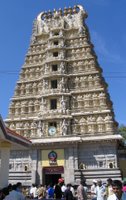 Chamundi Hill
Chamundi HillChamundi Hill is the location of the temple to the Goddess Chamundeshwari (Durga Devi) who vanquished the demon-king Mahishasura. Mahishasura once ruled the area, but was defeated by Durga Devi after a humungous 10 day struggle. The remembrance of the battle became a festival celebrated to this day in September known as Navaratri. This legend, important in Hindu mythology, renders the temple of the Goddess Chamundeshwari an important place of pilgrimage.
Our visit to Chamundi Hill took us up steep mountain roads two kilomete
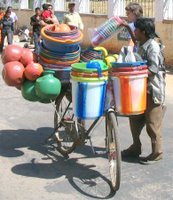 also didn’t
also didn’t  seem to be any less plastic refuse on the side of the road there than anywhere else in India. Upon arriving at the top, we were greeted not by the many open arms of Durga Devi, but a massive statue of the vanquished Mahishasura. Families took turns posing for a snap in front of the menacing demon-king statue. Go figure.
seem to be any less plastic refuse on the side of the road there than anywhere else in India. Upon arriving at the top, we were greeted not by the many open arms of Durga Devi, but a massive statue of the vanquished Mahishasura. Families took turns posing for a snap in front of the menacing demon-king statue. Go figure.The temple to Chamundeshwari sits on an expansive hilltop. Many small stalls sell the requisite articles for worship, or pooja, such as coconuts, marigold flowers and lotus blossoms. An assortment of street hawkers occupies the grounds surrounding the temple. The
 atmosphere is carnival-like, but the worshipers were most devout. Durga Pooja is the worship of the divine power. In the struggle between evil and the good, the dark forces eventually succumb to the divine. This victory of good over the evil is also the inner struggle of human beings to finally rise to the highest level of consciousness. There was true devotion among the people about us.
atmosphere is carnival-like, but the worshipers were most devout. Durga Pooja is the worship of the divine power. In the struggle between evil and the good, the dark forces eventually succumb to the divine. This victory of good over the evil is also the inner struggle of human beings to finally rise to the highest level of consciousness. There was true devotion among the people about us. Long lines formed to enter the temple. Crowds
Long lines formed to enter the temple. Crowds 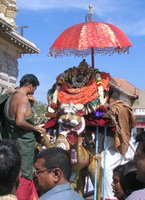 milled about outside, some conducting another form of pooja at a small location directly opposite the temple entranceway. Amid all this activity, bare-chested priests emerged from the temple and adorned an idol, placed atop a small pull cart, with garlands of flowers. Men with long horns,
milled about outside, some conducting another form of pooja at a small location directly opposite the temple entranceway. Amid all this activity, bare-chested priests emerged from the temple and adorned an idol, placed atop a small pull cart, with garlands of flowers. Men with long horns,  drums and other instruments began to play (audio). People clasped their hands
drums and other instruments began to play (audio). People clasped their hands  in devotional worship and a procession was formed as people pulled the idol-laden cart around the outer perimeter of the temple. We could be here for a million years and never fully understand all that we see.
in devotional worship and a procession was formed as people pulled the idol-laden cart around the outer perimeter of the temple. We could be here for a million years and never fully understand all that we see.We briefly followed the procession then found our
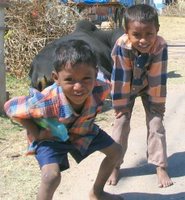 attention pulled to more recognized human behavior; two young boys were taunting a large black resting cow with a stick. Boys being boys! They mugged for the
attention pulled to more recognized human behavior; two young boys were taunting a large black resting cow with a stick. Boys being boys! They mugged for the 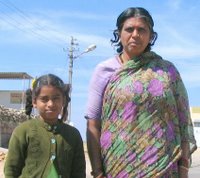 camera and we moved on. Shortly afterwards a young girl came up to us and asked “Pen?” Jay produced a pencil thinking she merely wanted a writing implement. “No. Not a pencil….a pen!” Clearly we had encountered a real go-getter with enough moxie to get want she needed to advance her schooling. A picture was taken of the little girl with her mom and we moved on.
camera and we moved on. Shortly afterwards a young girl came up to us and asked “Pen?” Jay produced a pencil thinking she merely wanted a writing implement. “No. Not a pencil….a pen!” Clearly we had encountered a real go-getter with enough moxie to get want she needed to advance her schooling. A picture was taken of the little girl with her mom and we moved on.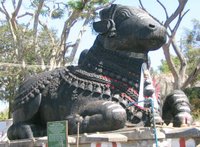
As we drove down the winding mountain road back to Mysore we stopped to visit a five-meter high Nandi, or bull, the symbol of Shiva. The Nandi was carved from a single block of black granite in 1659. The Nandi was adorned with flower garlands and was attended by a priest. More mystery for us to ponder.

0 Comments:
Post a Comment
<< Home